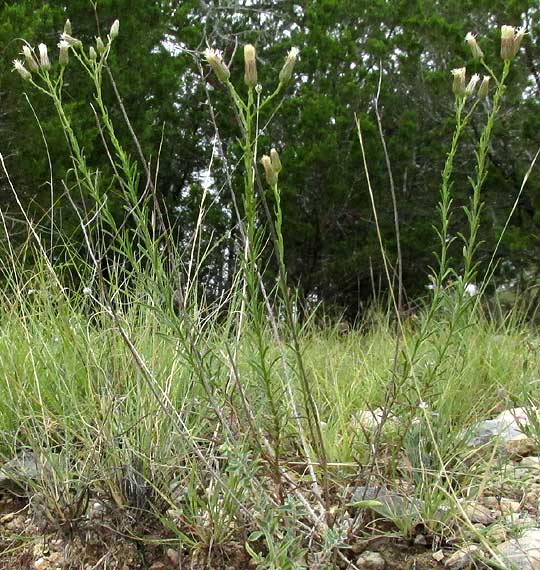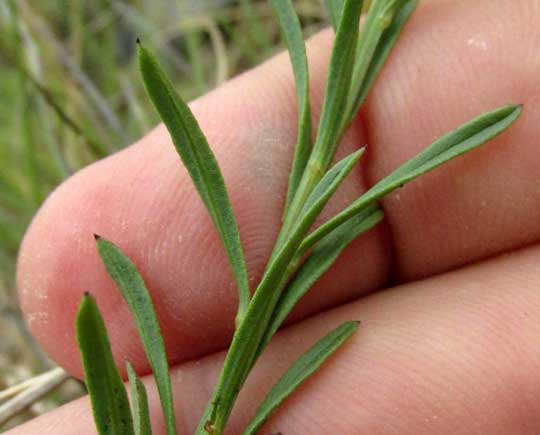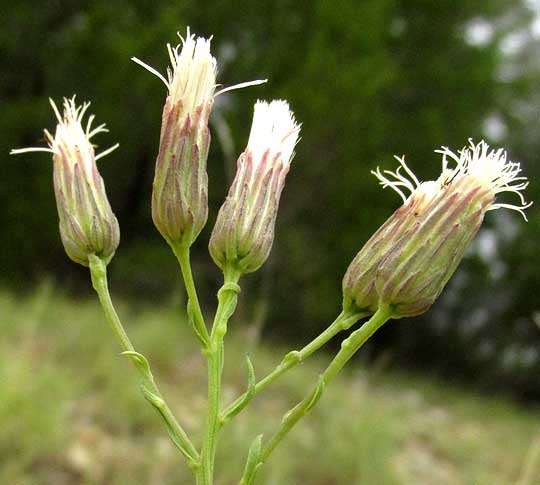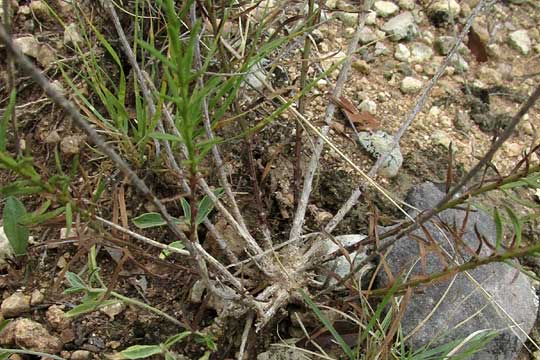Excerpts from Jim Conrad's
Naturalist Newsletter
from the September 21, 2014 Newsletter issued from the Frio Canyon Nature Education Center in the valley of the Dry Frio River in northern Uvalde County, southwestern Texas, on the southern border of the Edwards Plateau; elevation ~1750m (~5750 ft); N29.62°, W99.86°; USA
PRAIRIE FALSE WILLOW
In very thin soil at the rim of a roadcut through compacted, anciently deposited limestone gravel an interesting, knee-high member of the Composite or Daisy Family, the Asteraceae, showed up, as you can see below:

The small leaves were very short and narrow with single midveins leading to minute, sharp tips and arranged one per stem node (alternate) as shownbelow:

The white flowering heads were occupied with only cylindrical "disc flowers," with no "ray flowers" looking like petals along the heads' margins, as seen below:

Flowering heads in the huge Composite Family are of three kinds: Those with only disc flowers; those with only ray flowers, and; those with both. So noticing that this plant's heads contain only disc flowers automatically disqualifies the vast majority of eligible Composite Family species our roadcut plant possibly could be.
In our part of the world when you see flowering heads like these you might think of the big group known variously as bonesets, thoroughworts or snakeroots, all previously regarded as members of the genus Eupatorium, though now that venerable genus has been split into numerous smaller ones. However, all the Eupatoriums I've ever known have been herbaceous. Our roadcut one is definitely a perennial with a woody base, as shown below:

So, that woody base is what caught my attention and set me scratching my head. In our area we do have another Composite Family group of plants with similar leaves, flowering heads and woody bases, the erosion-preventing Roosevelt Weeds, Baccharis neglecta, so common along the banks of the little Dry Frio River, but those are large, much branching shrubs ten feet high and taller (3m). You might enjoy seeing how similar the plants are in nearly every respect other than size and general form, on our Roosevelt Weed page at http://www.backyardnature.net/n/w/roosvelt.htm.
However, in the end our little roadcut bush did reveal itself as another of the same group as Roosevelt Weed, the genus Baccharis. It's BACCHARIS TEXANA, usually known as the Prairie False Willow, Prairie Baccharis or False Willow. In the US it's found naturally only in Texas, Oklahoma and New Mexico, but it extends as well into arid northeastern Mexico.
Like the Eupatoriums, Prairie False Willow in flower attracts pollinators such as butterflies and bees, and later its heads of dry, cypsela-type fruits provide fine gnawings for small seed-eating birds. It's also an excellent candidate for xeriscaping, and is sold in certain arid-country garden shops.